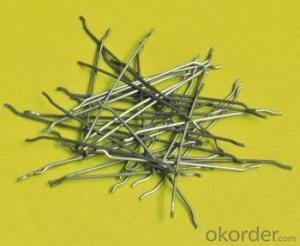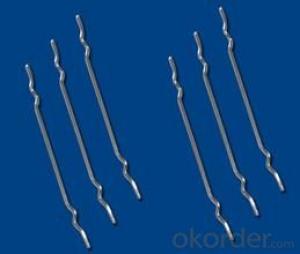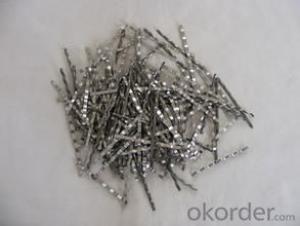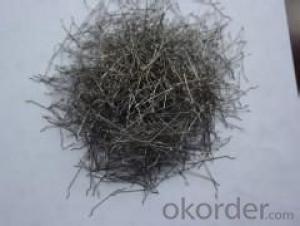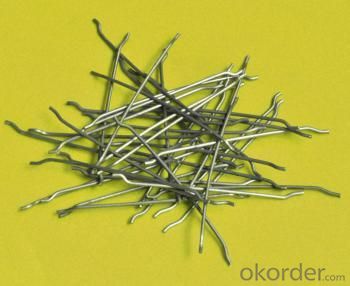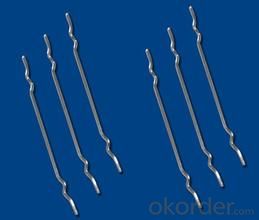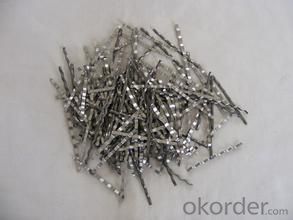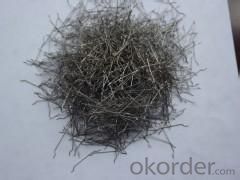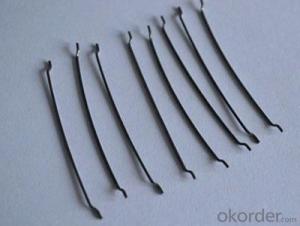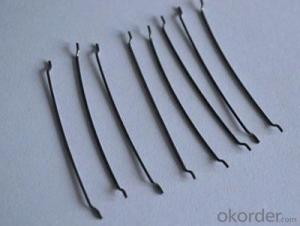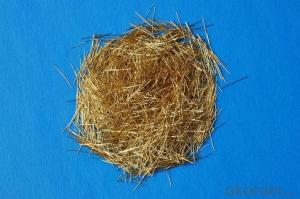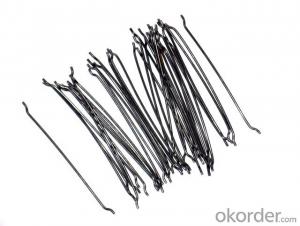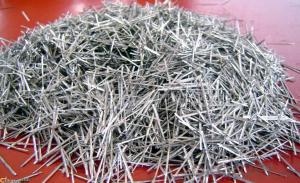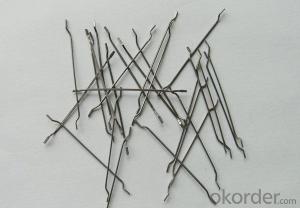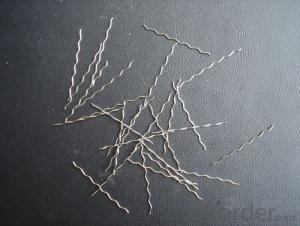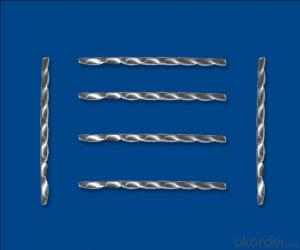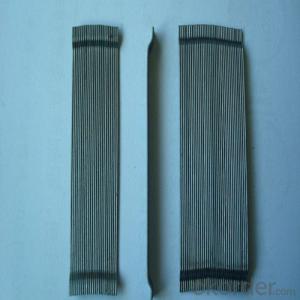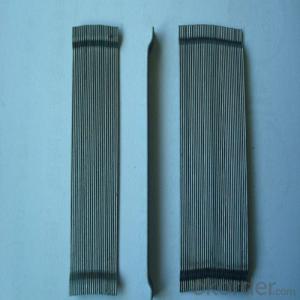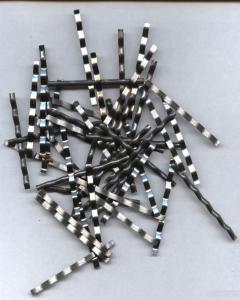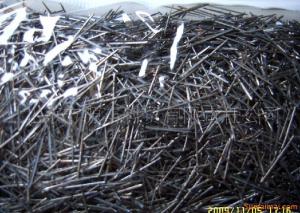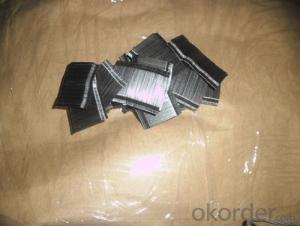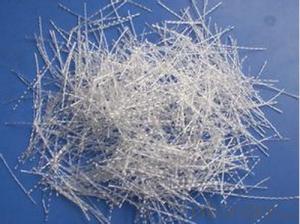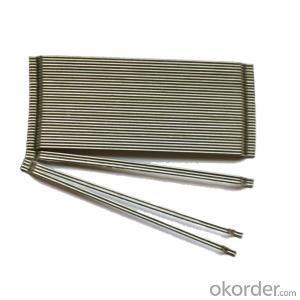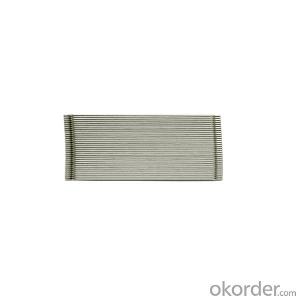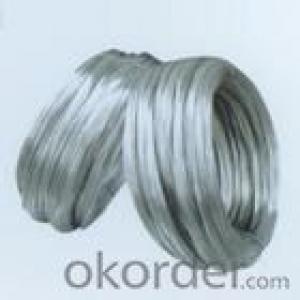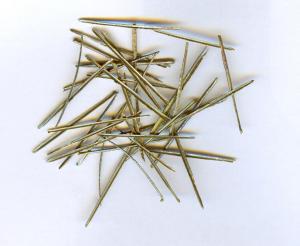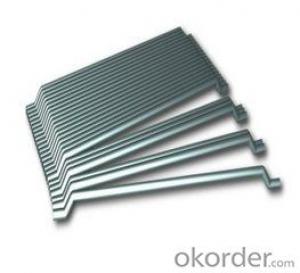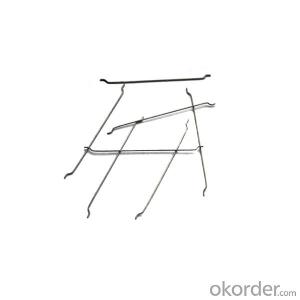Steel Fiber With concrete Admixtures For Concrete
- Loading Port:
- Tianjin
- Payment Terms:
- TT or LC
- Min Order Qty:
- 2000 kg
- Supply Capability:
- 250000 kg/month
OKorder Service Pledge
OKorder Financial Service
You Might Also Like
Quick Details
Place of Origin: Shandong, China (Mainland), Shandong, China (Mainland)
material: steel wire
type: wavy steel fiber
shape: corrugated flat fiber
usage: concrete reinforcement
appearance: clear and bright
Product features
steel fiber are for concrete construction, greatly improves concrete bonding and tensile strength .
The steel fiber is made of high-quality low carbon steel wire,with the characteristic of the high tensile strength,good toughness,etcs.This product is widely used in the construction fields for concrete reinforcement
or the shotcrete for tunnle.According to the standard of JG/T3046-1999 Steel Fiber Concrete, YB/T 151-1999 Steel Fiber for Concrete and ASTM AB820-90 Steel Fiber for the Fiber-Rinforced Concrete.
Specifications
The Specification of Hooker Ends Steel Fiber | ||||
TYPE | Diameter(mm) | Length(mm) | Length/Diameter | Tensile strength |
LB-60/60 | 1.0 | 60 | 60 | >=1000Mpa |
LB-50/50 | 1.0 | 50 | 50 | >=1000Mpa |
LB-65/60 | 0.9 | 60 | 65 | >=1000Mpa |
LB-55/50 | 0.9 | 50 | 55 | >=1000Mpa |
LB-80/60 | 0.75 | 60 | 80 | >=1000Mpa |
LB-45/35 | 0.75 | 35 | 45 | >=1000Mpa |
LB-55/30 | 0.55 | 30 | 55 | >=1000Mpa |
LB-60/30 | 0.5 | 30 | 60 | >=1000Mpa |
LB-50/25 | 0.5 | 25 | 50 | >=1000Mpa |
LB-60/25 | 0.4 | 25 | 60 | >=1000Mpa |
Picture
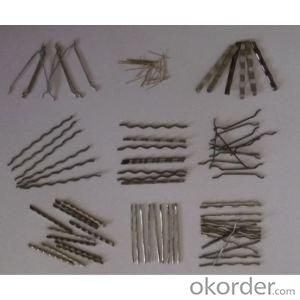
steel fiber for concrete reinforcement
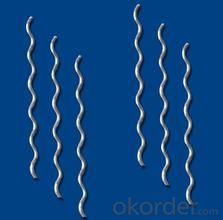
FAQ
We can produce any type steel fiber and of course we can make production according to your requirement
We have specilize in this field for almost 10 years ,with good quality and competitive price
Steel fiber are for concrete construction, greatly improves concrete bonding and tensile strength .
The steel fiber is made of high-quality low carbon steel wire,with the characteristic of the high tensile strength,good toughness,etcs.This product is widely used in the construction fields for concrete reinforcement
or the shotcrete for tunnle.According to the standard of JG/T3046-1999 Steel Fiber Concrete, YB/T 151-1999 Steel Fiber for Concrete and ASTM AB820-90 Steel Fiber for the Fiber-Rinforced Concrete.
- Q: Can melt extract stainless steel fiber be used in airport runways or taxiways?
- Yes, melt extract stainless steel fiber can be used in airport runways or taxiways. Stainless steel fibers are known for their high strength and durability, making them suitable for heavy-duty applications like airport pavements. They can help improve the resistance to cracking and enhance the overall performance and lifespan of the runway or taxiway.
- Q: Can melt extract stainless steel fiber be used in high-strength lightweight concrete mixtures?
- Indeed, high-strength lightweight concrete mixtures can benefit from the utilization of melt extract stainless steel fiber. By incorporating these fibers into the concrete, its mechanical characteristics, such as tensile strength, flexural strength, and impact resistance, can be significantly improved. Moreover, these fibers can substitute conventional reinforcement techniques like steel bars or mesh, ultimately reducing the concrete's weight without compromising its structural soundness. Furthermore, the corrosion resistance provided by stainless steel fibers guarantees the durability and longevity of the concrete mixture. Thus, melt extract stainless steel fiber emerges as a fitting option for high-strength lightweight concrete mixtures.
- Q: Does melt extract stainless steel fiber enhance the crack resistance of concrete?
- Concrete's crack resistance is enhanced by melt extract stainless steel fiber. To improve the tensile strength and prevent crack formation and propagation, stainless steel fibers are added to concrete mixes. Acting as reinforcement within the concrete matrix, these fibers provide additional strength and durability. When evenly dispersed throughout the concrete, these fibers form a three-dimensional network that helps distribute stress and load more uniformly. This reduces the likelihood of cracks forming and spreading, ultimately enhancing the concrete's overall crack resistance. Melt extract stainless steel fibers possess a high melting point and excellent corrosion resistance, making them highly effective in harsh environments or when exposed to chemicals. These fibers can endure high temperatures and prevent spalling or cracking of the concrete under extreme conditions. Moreover, the inclusion of stainless steel fibers improves the impact resistance and flexural strength of the concrete, rendering it more resilient to cracking caused by external forces or dynamic loads. In summary, melt extract stainless steel fiber positively contributes to the crack resistance of concrete by reinforcing the material and enhancing its tensile strength. Consequently, this leads to a more enduring and long-lasting concrete structure.
- Q: What is the recommended mix design for concrete containing melt extract stainless steel fiber?
- The recommended mix design for concrete containing melt extract stainless steel fiber typically includes a higher dosage of fiber to enhance the mechanical properties of the concrete. It is generally recommended to use a fiber dosage of around 40-60 kg/m3 to achieve optimal results. Additionally, the mix design should consider the desired strength, workability, and durability requirements of the concrete. It is advisable to consult with a structural engineer or a concrete specialist to determine the specific mix design for a project involving melt extract stainless steel fiber.
- Q: Can melt extract stainless steel fiber be used in tunnel shotcrete applications?
- Yes, melt extract stainless steel fiber can be used in tunnel shotcrete applications. Stainless steel fibers are commonly added to shotcrete mixes to improve the overall performance and durability of the concrete. The addition of stainless steel fibers can enhance the tensile strength, impact resistance, and crack resistance of the shotcrete, making it suitable for tunnel applications where the concrete needs to withstand high pressures, vibrations, and potential ground movements. Melt extract stainless steel fibers are particularly beneficial due to their high tensile strength, corrosion resistance, and ability to disperse uniformly throughout the shotcrete mix. This ensures that the shotcrete has consistent reinforcement and can effectively withstand the harsh tunnel environment. Overall, melt extract stainless steel fiber is a reliable and effective choice for reinforcing shotcrete in tunnel applications.
- Q: How does melt extract stainless steel fiber improve the flexural strength of concrete?
- Melt extract stainless steel fiber improves the flexural strength of concrete by reinforcing the material and enhancing its resistance to cracking and bending. The addition of stainless steel fibers helps distribute stress throughout the concrete matrix, preventing the propagation of cracks and improving the overall structural integrity. The fibers act as reinforcement, bridging the gaps between aggregates and effectively increasing the flexural strength of the concrete.
- Q: What is the effect of melt extract stainless steel fiber on the drying shrinkage of concrete?
- Typically, the effect of melt extract stainless steel fiber on concrete's drying shrinkage is positive. These fibers are added to the concrete mix to help decrease overall drying shrinkage and the likelihood of cracks forming. During the drying process, concrete tends to shrink as the water evaporates. This shrinkage can create cracks, which can compromise the structure's strength and longevity. However, when melt extract stainless steel fibers are incorporated into the concrete mix, the shrinkage is significantly reduced. These fibers serve as reinforcement within the concrete, distributing stresses and strains more evenly. As a result, the chances of cracking during the drying process are reduced. Melt extract stainless steel fibers possess high tensile strength and excellent corrosion resistance, making them an ideal choice for this purpose. They also enhance durability and increase resistance to cracking caused by shrinkage and temperature fluctuations. To summarize, the addition of melt extract stainless steel fibers effectively minimizes drying shrinkage in concrete and decreases the risk of cracking. Consequently, it enhances the durability and longevity of the concrete structure.
- Q: What is the effect of melt extract stainless steel fiber on the impact strength of concrete?
- The addition of melt extract stainless steel fiber to concrete generally improves its impact strength. The fibers act as reinforcement, enhancing the concrete's ability to resist cracking and absorb energy upon impact. This results in a more durable and resilient concrete structure, capable of withstanding heavy loads and external forces.
- Q: What is the effect of melt extract stainless steel fiber on the bond strength of shotcrete?
- The effect of melt extract stainless steel fiber on the bond strength of shotcrete is that it significantly improves the bond between the shotcrete material and the substrate. The fibers create a three-dimensional reinforcement network within the shotcrete, enhancing its cohesion and adhesion properties. This increased bond strength leads to improved structural integrity, durability, and resistance to cracking and delamination in shotcrete applications.
- Q: What is the impact of melt extract stainless steel fiber on the shrinkage of concrete?
- The impact of melt extract stainless steel fiber on the shrinkage of concrete is that it helps to reduce or mitigate the shrinkage cracks that can occur during the curing and drying process of concrete. The steel fibers provide reinforcement and improve the overall strength and durability of the concrete, thereby reducing the potential for shrinkage and cracking.
Send your message to us
Steel Fiber With concrete Admixtures For Concrete
- Loading Port:
- Tianjin
- Payment Terms:
- TT or LC
- Min Order Qty:
- 2000 kg
- Supply Capability:
- 250000 kg/month
OKorder Service Pledge
OKorder Financial Service
Similar products
Hot products
Hot Searches
Related keywords
